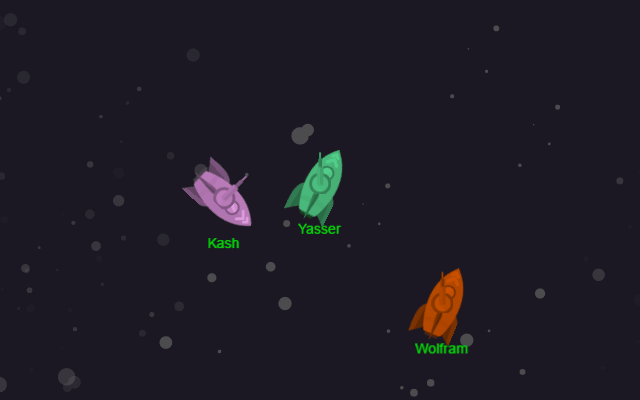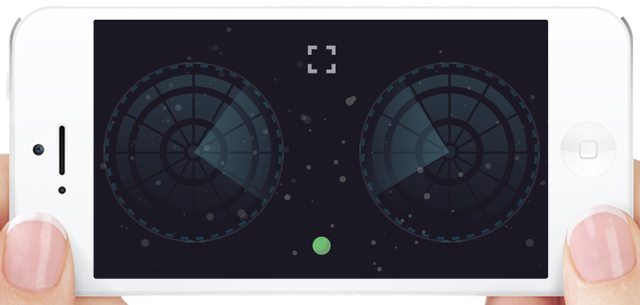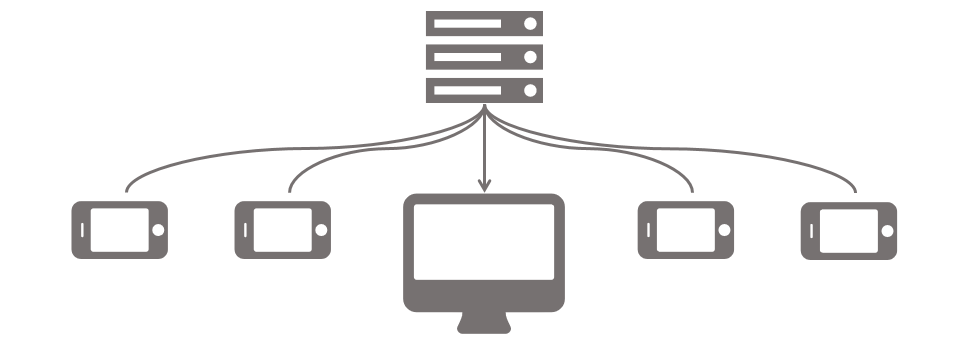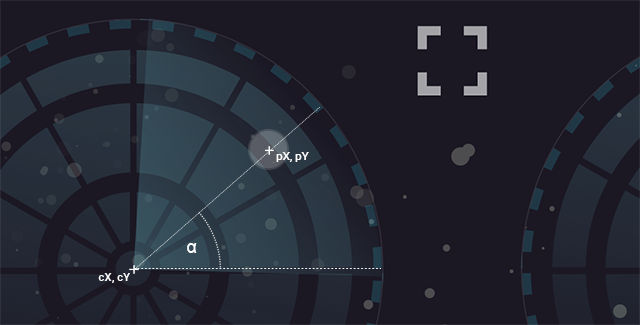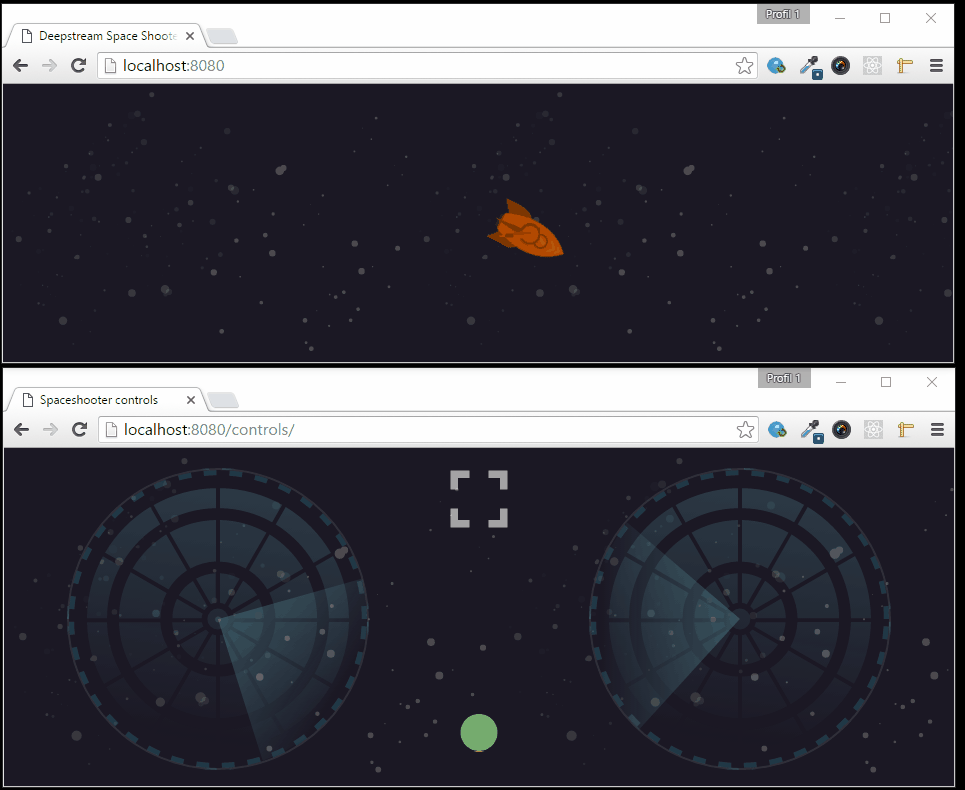Space - the final frontier. And a surprisingly good place to blow stuff up. In this tutorial we'll walk through the steps of building a multiplayer space shooter - but one with a twist: Rather than everyone playing away on their own computer, we'll bring the spirit of good old living-room co-op to the modern age.
The game itself will run in a single browser window. Every player opens a URL on their smartphone which turns it into a gamepad and allows their ship to join the game.
<iframe width="640" height="360" src="https://www.youtube.com/embed/fSl7KisexCc?rel=0&controls=0&showinfo=0" frameborder="0" allowfullscreen></iframe>Let's keep things simple: We'll use Pixi.js for rendering and deepstream.io as a multiplayer server.
Pixi.JS is a 2D rendering library for browsers. It uses WebGL and leaves the heavy lifting to the GPU if possible, but falls back to canvas if not. Pixi is just that: a rendering library, giving you all the Stage, Sprite and Container objects you'd expect, but no game logic constructs - those are our job.
deepstream.io is a new type of server for realtime connectivity. It handles all sorts of persistent connections, e.g. TCP or Websocket for browsers and provides high level concepts like data-sync, pub-sub and request-response. But most importantly for this tutorial: It's superfast.
We want this velvety smooth 60 FPS framerate - and we want our controls to play along. This means that every touch on the gamepad needs to be translated into an action on the screen in less than 16.6 milliseconds (one frame) - something pixi and deepstream are perfectly capable of.
But there's also network latency! Information needs time to travel - for optic fibre about 67ms for 10.000km, not counting switches, routers and other network hops that further slow it down. That means that if you're running your server in the US and play in Europe, your game won't feel particularly responsive.
This tutorial will take you through the high level concepts and all the tricky bits of the implementation - for brevities sake it skips a lot of project setup, css / styling and most of the more common aspects. To get an impression of how everything fits together, quickly head over to the Github Repository - don't worry, I'll wait.
This tutorial makes liberal use of new browser features like WebGL and ES6 syntax. It works well in all latest browsers (tested in Chrome 51, FF 47 & Edge 25), but won't be much fun in your good old IE 8.
Let's start by creating three files:
- game.js will contain the main game object that creates the PIXI stage, adds and removes spaceships to it and manages the game loop (more about that later)
- spaceship.js will represent a single player / spaceship
- index.js will start everything up
PIXI is based on hierarchies of display objects such as "sprites" or "movie clips". These objects can be grouped in "containers". Every PIXI project starts with an outermost container that we'll call "stage".
//in game.js
class Game{
constructor( element ) {
this.stage = new PIXI.Container();
}
}To turn your object-hierarchy into an image, you'll need a "renderer". PIXI will try to use WebGL for rendering, but can fall back canvas if necessary.
For our spaceshooter, we'll leave it to PIXI to decide which renderer to use. The only requirements are: It needs to extend to the full size of the screen and shouldn't have a background color (so that we can place a spacy image behind it)
To create a renderer, add the following lines to your game class' constructor:
this.renderer = PIXI.autoDetectRenderer(
window.innerWidth,
window.innerHeight,
{transparent: true},
false
);
element.appendChild( this.renderer.view );
}Time to add a spaceship to our stage. Our ship will be composed of small images, called "Sprites". To create one, we'll tell PIXI to create a PIXI.Sprite.fromImage( url ) and move it to its initial coordinates.
By default, these coordinates specify the top-left corner of our sprite. Instead, we want them to specify the center, so we also need to set the sprite's anchor position to 0.5 for both x and y. This will also be used as the pivot-point when we rotate the sprite later on. Finally, we'll add the spaceship to the stage.
// in spaceship.js
class SpaceShip{
constructor( game, x, y ) {
this._game = game;
this._body = PIXI.Sprite.fromImage( '/img/spaceship-body.png' );
this._body.position.x = x;
this._body.position.y = y;
this._body.anchor.x = 0.5;
this._body.anchor.y = 0.5;
this._game.stage.addChild( this._body );
}
}So - where's our spaceship? We've created a stage and a renderer so far, but we haven't told the renderer to render the stage yet. We'll do this by adding a method called _tick().
Why don't we just call it render() or something sensible like that? Because this method will become the pacemaker for our game. Every time a frame is about to be rendered, this method will calculate the amount of time that has passed since the last frame, notify all the objects in the game about the impeding update, render the stage and finally schedule the next frame.
For this, we'll use a browser method called requestAnimationFrame( callback ). This schedules a function to be executed the next time a frame can be drawn. We'll add this method twice in game.js - once at the end of our constructor to draw the initial frame and once from within our _tick() method itself.
// in game.js
constructor( element ) {
...
requestAnimationFrame( this._tick.bind( this ) )
}
_tick() {
this.renderer.render( this.stage );
requestAnimationFrame( this._tick.bind( this ) );
}If everything worked, your game should now look like this:
So far, so good, but our spaceship still looks a bit pale. And no wonder, the sprite we've used was just a grayscale image. To add a different color for each player, we need to set a property called tint.
this._body.tint = 0x00FF00; // green in hexresulting in
Next up: the turret. A bit of refactoring is in order. The spaceship's body and turret have to move in unison and need to be positioned relative to each other. To achieve this, we'll create a PIXI.Container and put both our spaceship's body and the turret inside.
Let's change the code in the spaceship's constructor to:
// container
this._container = new PIXI.Container();
this._container.position.x = x;
this._container.position.y = y;
// body
this._body = PIXI.Sprite.fromImage( '/img/spaceship-body.png' );
this._body.tint = this.tint;
this._body.anchor.x = 0.5;
this._body.anchor.y = 0.5;
this._container.addChild( this._body );
// turret
this._turret = PIXI.Sprite.fromImage( '/img/spaceship-turret.png' );
this._turret.tint = this.tint;
// the turret doesn't sit exactly at the center of the ship
this._turret.anchor.x = 0.45;
this._turret.anchor.y = 0.6;
// the turret's pivotin point is towards the bottom of the sprite
this._turret.pivot.x = 1;
this._turret.pivot.y = 7;
this._container.addChild( this._turret );
// add the whole container to the stage
this._game.stage.addChild( this._container );our spaceship should now look reasonably complete
Each spaceship will be individually controlled by a player via a smartphone-turned-gamepad. The control scheme is simple: Touching the left pad moves the ship, touching the right pad shoots, both are independent and work at 360 degrees - if you've ever played games like Super Smash TV on the Super Nintendo you know the drill.
Technically, the gamepad is just another HTML page with its own CSS and JavaScript. Both the controls and the game are connected to a deepstream server. User-input from each player's gamepad is stored in a record which deepstream syncs with the game itself.
From here on, you'll need a running deepstream server. Just get the version for your operating system from the install page and follow the instructions there.
Once your server is running, its time to get started on the controls. We'll gloss over the HTML and CSS and focus purely on the JavaScript part.
deepstream uses small client libraries to connect to the server and interact with it. For our example, we'll need the JavaScript client. You can get it from a CDN
<script src="https://cdn.rawgit.com/deepstreamIO/deepstream.io-client-js/master/dist/deepstream.min.js"></script>or install it via Bower or NPM
bower install deepstream.io-client-js
npm install deepstream.io-client-jsTo connect your controls to the server, simply add a javascript file, e.g. controls.js and call
ds = deepstream( 'localhost:6020' ).login({}, function( success ){
// the code for our controls will go in here
});You might notice that we've fallen back to function and ES5 syntax. ES6 support isn't as established on phones as it is on desktop. If you prefer to stick with ES6, you can always use a transpiler like Babel.
Time to dive into the mechanics behind our game: records.
Records are small bits of data that can be manipulated and observed. They have get(), set() and subscribe() methods that let you interact with the whole data structure or with a path within it, e.g. ship.subscribe( 'turretRotation', angle => {/.../}).
Each change to a record is synced across all connected clients. For our tutorial, all game logic will life in the main browser window. User-input from the gamepads is written to records and synced with the game via deepstream.
Each record is identified by a unique name. For our game, we'll use the player's username, e.g. player/johndoe.
ds.record.getRecord( `player/johndoe` ).whenReady(function( record ) {
// Interact with the record here
});Once the record is ready it's time to set its initial value:
record.set({
// the name of the player
name: name,
// is the move pad currently touched?
moving: false,
// is the shoot pad currently touched?
shooting: false,
// in radians
bodyRotation: 0,
// in radians
turretRotation: 0
});From here on, these values will be updated whenever the user interacts with one of the control pads. We'll use a simplified version of the code for this tutorial, to get the full picture have a look here
First off, let's start with some basic interactions. Every time the user touches a pad, we want to set moving or shooting to true and back to false again once the touch ends:
var area = $( '.area' );
area.on( 'touchstart', function( event ){
record.set( 'moving', true );
});
area.on( 'touchend', function( event ){
record.set( 'moving', true );
});Next up, we want to sync the angle of the user's touch with the ship / turret in the game. Every touchmove event provides the x and y coordinates of where the touch happened. Since we know the center of our gamepad, we can now calculate the angle of the touch in radians:
For this we'll use the arctangent function with two arguments... don't worry, that sounds harder than it is:
var radius = area.width() / 2;
var cX = area.offset().left + radius;
var cY = area.offset().top + radius;
area.on( 'touchmove', function( event ){
var pX = event.targetTouches[ 0 ].clientX;
var pY = event.targetTouches[ 0 ].clientY;
var angle = Math.PI / 2 + Math.atan2( pY - cY, pX - cX );
record.set( 'bodyRotation', angle );
});That's enough controls for now, let's head back to our main game. The first thing we'll have to do is to connect our game to the deepstream server as well and request the same player/johndoe record from within our spaceship class. To do this, just follow the same steps as for the controls.
A game loop is a central concept of almost every game. Game loops typically consist of two phases: "update" and "draw".
In the update phase, each entity within the game updates its position, orientation, health, status and so on.
This is usually followed by a global update phase that determines whether each player is still alive, being hit etc.
Finally, the next frame of the game is drawn by the renderer. This loop happens continuously for every frame, ideally 60 times a second. This means that the logic that's executed on every tick needs to be as performant as possible.
For our spaceshooter, we'll create a simple gameloop by having the game class emit an update event every time before the renderer kicks in. Our spaceship can now subscribe to this event. As usual, we'll keep things simple for this tutorial. You can find the full update cycle for the spaceship here
To apply the input from our controls, we simply get the data from the record and set it as the body's and turret's rotation parameter
module.exports = class SpaceShip{
constructor( game, name ) {
this._record = global.ds.record.getRecord( 'player/' + name );
this._game = game;
//...
this._game.on( 'update', this._update.bind( this ) );
}
_update() {
var data = this._record.get();
this._container.rotation = data.bodyRotation;
this._turret.rotation = data.turretRotation - data.bodyRotation;
//...
}
}Now whenever we touch either control pad, our ship's body or turret should rotate accordingly on the screen:
Phew, thanks for holding out with me for so long. We've now got all the essential bits in place, but at the moment our spaceship doesn't move or shoot and generally just sits around there like a fish on dry land. The good news is: we'll cover all the good stuff in part 2 of this tutorial.
There you'll learn how to add / remove players dynamically whenever a client connects, add proper asset loading, handle shooting and hit detection, handcraft some awesome explosions and deal with player destruction / recreating.
Stay tuned...
